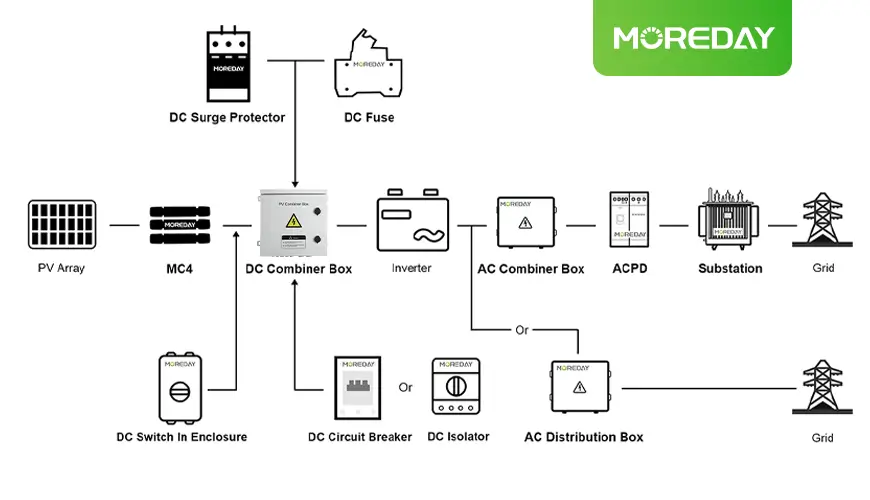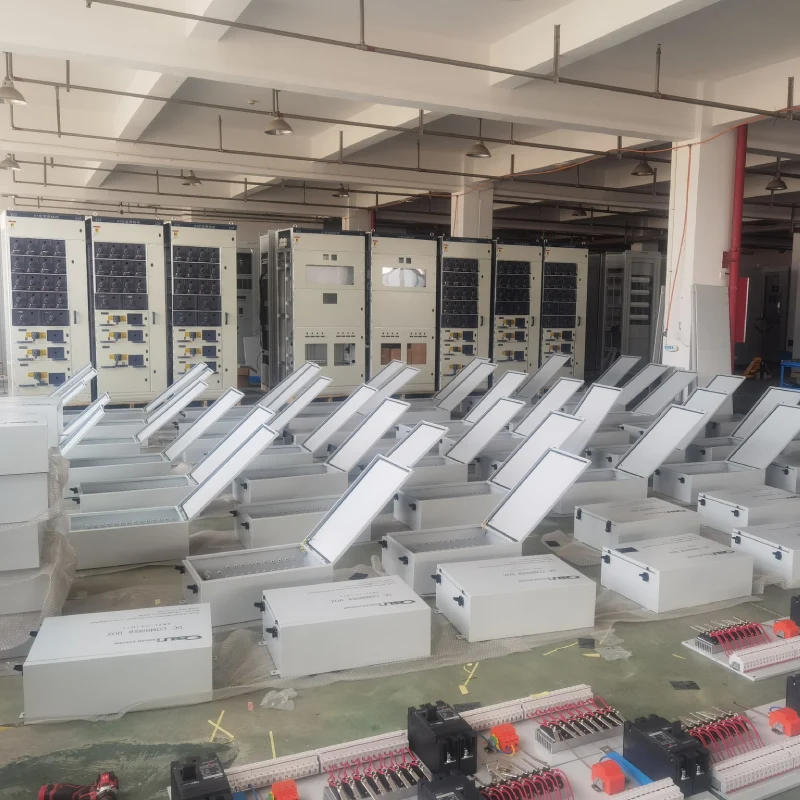When One Wrong Component Choice Costs You Thousands
You’ve just finished designing a 50kW commercial rooftop solar installation. Twelve strings of high-efficiency panels. Three string inverters. The layout is optimized, the structural calculations check out, and your client is thrilled with the projected ROI. You’re finalizing your bill of materials when your supplier calls with a simple question:
“Do you need an AC combiner box or a DC combiner box?”
You pause. You know you need a combiner box—the system has multiple outputs that need consolidation. But suddenly, the distinction feels critical. You’ve heard horror stories: an installer in Phoenix who mixed up the two types and faced a failed inspection, forcing a complete electrical rework. Another contractor who used AC-rated components on the DC side, only to have a catastrophic arc fault shut down a 200kW system six months after commissioning.
The stakes are real: Choose the wrong combiner box type, and you’re looking at rejected inspections, unsafe operation, expensive reinstallation, and a damaged professional reputation. So here’s the question every solar professional faces: What’s the actual difference between AC and DC combiner boxes, and how do you make the right choice—every single time?
Why This Confusion Exists (And Why It Matters)
The problem starts with the name. Both products are called “combiner boxes” because they both consolidate multiple electrical outputs into a unified feed. On the surface, they seem interchangeable—just boxes with inputs and outputs, right?
Wrong. Dangerously wrong.
Here’s what most engineers miss: AC and DC combiner boxes operate at fundamentally different points in the solar power conversion process. A DC combiner box handles the raw, high-voltage direct current coming straight from your solar panels—we’re talking 600V to over 1,500V DC in modern systems. An AC combiner box, on the other hand, manages the converted alternating current after it’s passed through the inverter, typically at standard grid voltages of 120V to 480V AC.
But voltage isn’t the only difference. DC and AC electricity behave fundamentally differently during fault conditions. DC arcs are notoriously difficult to extinguish compared to AC arcs (which naturally extinguish at zero-crossing points 120 times per second). This means that using AC-rated circuit breakers in a DC application isn’t just inefficient—it’s a fire hazard waiting to happen. The components look similar, but they’re engineered for completely different electrical behaviors.
Özetle: Confusing these two products isn’t like choosing between two brands of the same component. It’s like trying to use a water pump to move air—the tool simply doesn’t match the task, and the consequences can be severe.
The “Aha!” Moment: Think in Terms of System Position
Here’s the insight that transforms this from confusing to crystal clear: Stop thinking about combiner boxes as interchangeable products. Start thinking about your solar system as having two distinct electrical “sides.”
The DC Side: Solar panels → DC combiner box → Inverter (input side)
The AC Side: Inverter (output side) → AC combiner box → Grid connection
Your solar panels generate direct current. Multiple strings of panels produce multiple DC outputs. If you have enough strings (typically 4 or more), you need a DC combiner box to consolidate these outputs before sending them to the inverter’s input terminals. This box lives in “DC territory”—it’s handling raw solar energy before any conversion happens.
Once the inverter converts that DC power to AC, you’re in different territory. If you have multiple inverters (common in large installations) or you’re using microinverters (where each panel has its own tiny inverter), you now have multiple AC outputs that need consolidation before connecting to your main electrical panel or the grid. That’s where an AC combiner box comes in.
The critical distinction: These boxes aren’t competing products—they serve opposite sides of the power conversion process. Understanding this single concept eliminates 90% of the confusion.
The Engineer’s Three-Step Selection Framework
Now that you understand the fundamental difference, let’s walk through the systematic process for choosing correctly. Follow these three steps, and you’ll never select the wrong combiner box again.
Step 1: Map Your System Architecture and Power Flow
The first step is to identify exactly where in your system you need to consolidate power. Draw out your power flow from panels to grid, and mark every point where multiple outputs converge.
For string inverter systems (most commercial installations), your multiple panel strings create multiple DC outputs. These need to be combined BEFORE reaching the inverter. You’re looking at the DC side, so you need a DC combiner box. The typical setup looks like this:
- 12 panel strings (each producing 30-40A at 600-1,000V DC)
- All strings feed into one DC combiner box
- Single high-capacity cable (250-400A) runs from the combiner box to the string inverter input
This configuration slashes installation costs by eliminating 11 long cable runs and simplifies troubleshooting dramatically.
For microinverter systems (popular in residential installations), each panel or small group of panels has its own inverter mounted on the rack. These create multiple AC outputs—potentially dozens of them—that need consolidation before connecting to your main panel. You’re on the AC side now, so you need an AC combiner box. The setup:
- 20 microinverters (each outputting 240V AC)
- All AC outputs feed into one AC combiner box
- Single AC feed runs from combiner box to main service panel
Pro-Tip: In hybrid systems with both string inverters AND battery storage, you might need BOTH types of combiner boxes—a DC box for the panel strings going into the inverter, and an AC box if you have multiple inverters feeding the facility or grid. The key is to trace the power flow and identify where each type of current needs consolidation.
Step 2: Match Voltage, Current, and Component Ratings
Once you know which side of the inverter you’re working on, you need to ensure your combiner box can handle the electrical characteristics of that location. This is where component ratings become critical.
DC Combiner Box Gereksinimler:
Modern solar systems push voltage limits higher to reduce current (and therefore wire size and loss). Utility-scale installations increasingly use 1,500V DC systems. Your DC combiner box must be rated for these high voltages, typically ranging from 600V to over 1,500V DC depending on your string configuration.
But here’s the critical safety point: Every component inside a DC combiner box must be DC-rated. This includes:
- DC-rated fuses or circuit breakers (typically 10-20A per string, depending on panel specifications)
- DC-rated disconnect switches for safe maintenance
- Type 2 or Type 1+2 surge protection devices (SPDs rated for DC applications, capable of handling 20-40kA discharge currents from lightning strikes)
- DC-rated busbars for current consolidation
Why does this matter? Because a standard AC circuit breaker might look identical to a DC-rated one, but it won’t reliably interrupt a DC arc. Using AC components in DC applications is one of the leading causes of solar system fires.
AC Combiner Box Requirements:
AC combiner boxes handle much more familiar voltage levels—typically 120V, 208V, 240V, or 480V AC, depending on whether you’re in a residential, commercial, or industrial setting. The components are different:
- AC-rated circuit breakers for each inverter output (sized according to inverter output capacity, typically 15-60A)
- AC surge arrestors to protect against grid voltage spikes
- Current transformers (CTs) for production monitoring
- Grid synchronization components in larger systems
The Four-String Rule: Here’s a practical guideline that saves unnecessary costs: systems with fewer than four solar strings can typically connect directly to the inverter without a DC combiner box. Once you hit four or more strings, the cost savings in reduced wiring and improved safety from centralized protection justify adding a combiner box. For AC systems, if you have more than three microinverters or multiple string inverters, a combiner box simplifies your installation significantly.
Step 3: Verify Safety Features and Certifications
The final step—and the one that ensures long-term reliability—is confirming that your combiner box has the proper safety features and certifications for your jurisdiction.
Essential DC Combiner Box Safety Features:
- Ark arıza koruması: Advanced DC combiner boxes include arc fault circuit interrupters (AFCIs) that detect the unique signature of dangerous DC arcs and disconnect the circuit before fire can start. Given that DC arcs can reach temperatures exceeding 3,000°C, this isn’t optional for large systems.
- String-level monitoring: While not strictly a safety feature, string-level voltage and current monitoring allows you to identify underperforming or failed strings immediately, preventing cascade failures and catching problems before they become dangerous.
- Integrated disconnect switches: National Electrical Code (NEC) requires accessible disconnect points for DC circuits. Your DC combiner box should provide this functionality, allowing safe de-energization during maintenance.
- IP65 or NEMA 3R rating: Solar equipment lives outdoors for 25+ years. Your combiner box enclosure must resist moisture, dust, and UV degradation.
Essential AC Combiner Box Safety Features:
- Overcurrent protection with proper interrupt ratings: Your AC circuit breakers must have sufficient interrupt capacity (AIC rating) for your specific grid connection. A typical utility grid might require 10kA or higher AIC ratings.
- Topraklama hatası koruması: Essential for preventing shock hazards and meeting code requirements. Many jurisdictions require ground fault detection on the AC side of solar installations.
- Surge protection rated for AC applications: Lightning and grid transients can destroy expensive inverters. Proper AC surge protection devices (SPDs) guard your investment.
Sertifikasyon Gereksinimleri:
Before you finalize your purchase, verify these certifications:
- UL 1741 (North America): Required for grid-connected PV equipment
- NEC compliance: Your combiner box must meet current National Electrical Code requirements (2023 edition as of this writing)
- IEEE 1547: For grid interconnection standards
- IEC 61439 (international): For low-voltage switchgear and controlgear assemblies
Pro-Tip: Don’t assume a combiner box has all necessary certifications just because it’s being sold. Verify the certification labels, and confirm they’re valid for your jurisdiction. Using uncertified equipment can void your insurance, fail inspection, and put you in legal jeopardy if something goes wrong.
Your Decision Framework in Action
Let’s bring this all together with real-world application examples:
Scenario 1 – 50kW Commercial Rooftop (Your Original Question)
- System: 12 strings of panels feeding 3 string inverters
- Decision: DC combiner box (consolidates the 12 DC strings before inverters)
- Specs needed: 1,000V DC rating, 12 input circuits, 250A+ output capacity, DC-rated fuses and SPDs
- Result: Clean installation with one combiner location and three cables to inverters
Scenario 2 – 15kW Residential with Microinverters
- System: 40 solar panels, each with its own microinverter outputting 240V AC
- Decision: AC combiner box (consolidates 40 AC outputs from microinverters)
- Specs needed: 240V AC rating, 40 input breakers (typically 15A each), production metering CTs
- Result: Organized AC collection point with single feed to main service panel
Scenario 3 – Hybrid Commercial System with Battery Storage
- System: 8 strings to 2 string inverters, plus AC-coupled battery system
- Decision: One DC combiner box AND one AC combiner box
- DC box: Consolidates 8 panel strings before the 2 string inverters
- AC box: Consolidates outputs from the 2 inverters plus battery inverter before grid connection
- Result: Clean power flow management on both DC and AC sides
The Bottom Line: Safety, Efficiency, and Professional Excellence
By following this three-step framework, you ensure:
- Proper component selection based on system position and current type
- Elektrik güvenliği through correct voltage/current ratings and DC-specific components
- Kod uyumluluğu with proper certifications and safety features
- Long-term reliability with purpose-built equipment for each application
- Professional credibility by getting it right the first time
The question “AC or DC combiner box?” isn’t a trivial detail—it’s a fundamental system design decision that affects safety, performance, and code compliance. The good news? Once you understand that these products serve opposite sides of the inverter (DC before, AC after), the choice becomes straightforward.
Remember the core principle: Trace your power flow from panels to grid. Where you need to consolidate multiple DC sources before the inverter, specify a DC combiner box with DC-rated components. Where you need to consolidate multiple AC sources after the inverter, specify an AC combiner box with AC-rated components. Match your component ratings to your voltage and current requirements. Verify certifications for your jurisdiction.
Get this right, and you’ll deliver safe, efficient, code-compliant solar installations that perform flawlessly for decades. Get it wrong, and you’re looking at failed inspections, dangerous operation, and expensive rework.
The choice is yours—but now you have the knowledge to choose correctly every time.
Need help specifying the right combiner box for your specific project? Consult with your electrical distributor or a solar design engineer to verify your component selections match your system requirements and local code. When in doubt, always prioritize safety and code compliance over cost savings.






